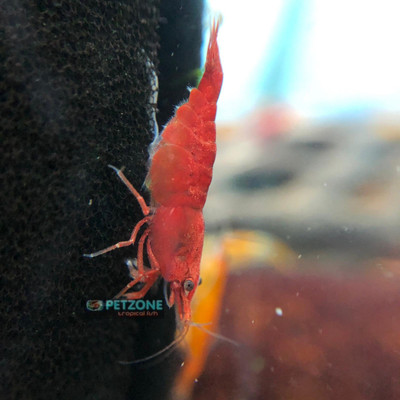Fire Red Dwarf Shrimp (Neocaridina davidi var. 'Fire Red')
Posted by Max Gandara on on 2nd Oct 2024
Fire Red Dwarf Shrimp (Neocaridina davidi var. 'Fire Red'): Care Guide and Origins
The Fire Red Dwarf Shrimp, a strikingly vibrant variety of Neocaridina davidi, is one of the most sought-after freshwater shrimp species in the aquarium hobby. Known for their brilliant red coloration and easy-going nature, these shrimp make an excellent choice for both beginner and experienced aquarists.
Origins and Natural Habitat
The Fire Red Dwarf Shrimp originates from the Neocaridina davidi species, which is native to the freshwater streams, rivers, and ponds of Taiwan and China. These shrimp have been selectively bred in captivity to enhance their vivid red coloration, making them stand out compared to their wild counterparts, which are typically more transparent or brownish in color.
In the wild, they inhabit areas with plenty of plant cover, rocks, and other hiding places, where they can scavenge for food and stay safe from predators. In captivity, these conditions can be easily mimicked to provide a suitable environment for them to thrive.
Aquarium Setup and Care
- Tank Size
Although Fire Red Dwarf Shrimp are small, growing up to just 1–1.5 inches (2.5–4 cm), they do best in tanks with a minimum size of 5 gallons (19 liters). A larger tank allows for more stable water parameters and ample space for the shrimp to graze and explore. - Water Parameters
To keep Fire Red Dwarf Shrimp healthy, stable water parameters are crucial:
- Temperature: 65–80°F (18–27°C)
- pH: 6.5–7.5
- Water Hardness: Soft to moderately hard water (GH 4-8, KH 1-4)
- Ammonia & Nitrite: 0 ppm (toxic to shrimp)
- Nitrate: Under 20 ppm (keep as low as possible)
Regular water changes of 10-20% weekly are recommended to maintain water quality, and a sponge filter or other shrimp-safe filtration system is ideal to avoid harming their delicate bodies.
- Substrate and Plants Shrimp prefer a planted tank with plenty of hiding spots and surfaces to graze on biofilm. A dark substrate, such as fine gravel or shrimp-safe aquarium soil, helps accentuate their red color. Popular plants like Java Moss, Anubias, and Dwarf Hairgrass not only provide aesthetic appeal but also offer shelter and grazing areas for your shrimp.
- Tank Mates
Fire Red Dwarf Shrimp are peaceful creatures, and it's important to choose tank mates carefully. Avoid keeping them with larger or aggressive fish that may see them as food. Ideal tank mates include:
- Small tetras (Ember Tetras, Neon Tetras)
- Nano fish (Chili Rasboras, Galaxy Rasboras)
- Other dwarf shrimp species
- Snails (Nerite Snails, Mystery Snails)
Many aquarists choose to keep Fire Red Shrimp in species-only tanks to avoid the risk of predation and to increase the chances of breeding success.
- Diet
Fire Red Dwarf Shrimp are scavengers and will feed on algae, biofilm, and detritus in your aquarium. However, it is essential to provide them with a balanced diet for optimal health:
- Algae wafers
- Blanched vegetables (zucchini, spinach, and cucumber)
- Specialized shrimp pellets
- Biofilm and decaying plant matter
Feeding them in moderation is key to preventing water quality issues, as overfeeding can lead to excess waste in the tank.
Breeding Fire Red Dwarf Shrimp
One of the appealing aspects of keeping Fire Red Dwarf Shrimp is how readily they breed in captivity if kept in the right conditions. Here are some tips:
- Stable water parameters and a well-planted tank are essential for successful breeding.
- Females will carry eggs under their swimmerets for about 30 days before releasing fully developed baby shrimp.
- Ensure the tank has plenty of biofilm and microalgae for the young shrimp (also called shrimplets) to feed on, as they are too small to eat larger foods right away.
The Fire Red Dwarf Shrimp is an excellent addition to any freshwater aquarium, offering a bright splash of color and an active presence. With their peaceful nature, low-maintenance care, and ease of breeding, they are a favorite for aquarists looking to create a beautiful and lively shrimp tank. By replicating their natural environment and ensuring stable water conditions, you’ll have a thriving colony of these dazzling shrimp in no time!

